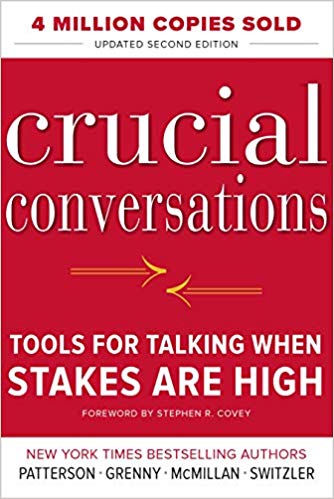

This article is an excerpt from the Shortform summary of "Crucial Conversations" by Kerry Patterson. Shortform has the world's best summaries of books you should be reading.
Like this article? Sign up for a free trial here .
What is Crucial Conversations‘ STATE method? What does crucial conversations STATE stand for, and how can it help you have a healthy dialogue?
Crucial Conversations‘ STATE is an acronym that helps you remember and cultivate a certain set of communication skills. Crucial Conversations‘ STATE method can help you talk about difficult topics. Keep reading to see how it works.
Crucial Conversations’ STATE: Setting the Stage
To speak honestly when it could offend others, you have to maintain safety by blending confidence and humility. This is where crucial conversations’ STATE comes in.
Confidence: You must have the confidence to say what needs to be said to the appropriate person (and not complain to someone else), and confidence that you can speak honestly without attacking the other person.
Humility: You must be humble enough to realize that you don’t know everything, and you don’t always have to get your way. Your opinion is a starting point for discussion. With new information you might change your mind — so you express your opinion and also encourage others to express theirs.
Crucial conversations’ STATE can help guide you through tough topics.
Crucial Conversations: STATE Your Path
To have a healthy conversation about a tough topic, you must take care not to violate respect or safety with threats and accusations, despite your worst fears. To create conditions conducive to dialogue:
- Start with heart: Think about what you really want and how dialogue can help you get it
- Master your story: Realize you may be jumping prematurely to a clever story: victim, villain, or helpless.
- Think about other possible explanations, to open your mind to dialogue.
Use five skills with the acronym STATE to talk about sensitive topics:
- Share your facts.
- Tell your story.
- Ask for others’ paths.
- Talk tentatively.
- Encourage testing.
The first three skills involve what to do. The last two are how to do it. All are part of the crucial conversations STATE plan.
What Skill #1: Share the Facts
Facts set the stage for all sensitive conversations. Start with the facts alone (which are observable), not your emotion-driven story (your conclusions). For example, a hotel receipt in your husband’s name is a fact — you can see it. Your belief about why he visited the hotel (absent his explanation) is a conclusion. In order to use the Crucial Conversations “state my path” plan, you have to know the facts.
Starting with your worst-case scenario or conclusion creates a self-fulfilling prophecy. When you blurt out your conclusions, it’s ineffective. You expect bad results and get bad results. Or you hold the story inside because you feel it’s too risky to share — tension builds up and you blow up, getting the bad results you feared.
Starting with facts avoids these problems. Here’s why:
- Facts are the least controversial: They provide a safe beginning. Facts are objective and noncontroversial while conclusions are highly subjective and controversial.
- Facts are the most compelling: Starting with factual observations is the best way to get others to listen. You want to give others a basis for understanding how a reasonable person could think what you’re thinking. You’re not trying to win but to get your meaning added to the pool and to get a fair hearing.
- Facts are least likely to offend: Because they’re neutral observations, facts are the least likely to offend or put others on the defensive. Starting with your story, on the other hand, could surprise and insult, and consequently derail dialogue.
- It’s important to begin at the beginning: Let others see the experience from your point of view, starting with your facts. When you offer your conclusions (your story), they’ll understand why.
Once you accept this first step, you’ll be able to move onto sharing your truth with the crucial conversations state my path plan.
What Skill #2: Tell Your Story
If you simply mention the facts, the other person may not understand the implications. For example, if you tell an employee, “I noticed you had company software in your briefcase,” they may not understand that you’re talking about a potential policy violation. You have to follow-up that observation with your conclusions.
It’s the combination of facts plus the conclusion there’s a problem that requires face-to-face discussion. State my path in crucial conversations lets you do this. When you tell your story:
- Take the risk: When you move from the facts to your conclusions, others can become defensive. But it’s necessary to take the risk.
- Be confident: It takes confidence to share a potentially upsetting story. However, if you’ve objectively examined the facts, you’ll come to a reasonable conclusion that deserves a hearing. You can be confident in adding important, though controversial, meaning to the pool.
- Be selective: Don’t just unload a pile of negative conclusions. Revise your villain story, so you can start in a non-threatening way: “My first reaction was to oppose your recommendation, but after thinking about it I realize I need to know more…”
- Be alert to safety problems: As you share your story, watch for signs that others are feeling threatened. If people get defensive, restore safety by contrasting what you don’t want and what you do want. But don’t minimize your message — be confident enough to speak your mind.
What Skill #3: Ask For Others’ Paths
Remember that the key to sharing controversial ideas is to blend confidence and humility. State my path in crucial conversations requires your self-awareness. Express confidence by sharing our facts and stories clearly. Then, express humility by asking others how they see it. Encourage them to express their facts, stories, and feelings. Listen closely and be willing to rethink your story as more information is presented.
How Skill #4: Talk Tentatively
You’ll get people to listen if you describe both your facts and stories in a tentative, non-dogmatic way. Speaking tentatively means telling your story as a story, not presenting it as an incontrovertible fact. For example, start with phrases indicating you’re sharing an opinion, not asserting a fact: “In my opinion…”, or “I’m beginning to wonder whether…” (rather than, “The fact is…” or “It’s obvious to me that…”).
Speaking tentatively also means sharing in a way that shows confidence in your conclusions, but that also suggests you’re open to challenges.
You soften the message because you’re trying to add meaning to the pool, not force it on people. If you’re overly assertive, your information won’t be accepted (won’t make it into the pool). The “state my path” Crucial Conversations plan is dependent on the delivery of your message, not just what you say.
In fact, when talking with people holding opposite opinions, the more convinced and forceful you act, the more resistant they’ll be. Speaking in absolutes decreases your influence. Conversely, the more tentatively you speak, the more open people become to your opinions.
Being tentative isn’t manipulative. You’re tentative because your opinions may not be totally accurate or your information may be incomplete. At the same time, you shouldn’t pretend to be less confident than you are. Just be aware that your observations and stories could be flawed.
How Skill #5: Encourage Testing
Sometimes others are reluctant to use the Crucial Conversations “state my path” plan (facts, stories, and feelings), and you need to be more encouraging. You need to make clear that no matter how controversial their ideas, you want to hear them. If they don’t feel comfortable speaking up, you can’t test the accuracy/value of your views.
This is especially important if you’re talking with someone with a tendency to move to silence (to make the fool’s choice of not saying anything to avoid risk). When others are reluctant to speak up, try these steps:
- Explicitly invite opposing views. Make it emphatically clear that you want to hear their views, no matter how different. If others disagree, you appreciate it and respect them for their courage in expressing their views. You need additional information to complete your story. Ask proactively: “What am I missing?”
- Be sincere: Sometimes an invitation for opposing views sounds more like a threat than sincere request: “Well that’s the way I see it; any disagreement?” Be inviting with both words and tone.
- Play devil’s advocate: Sometimes you can tell people disagree, but they aren’t speaking up. To encourage sharing, play devil’s advocate. Counter your own view: “Maybe I’m wrong here; what if…?”
- Persist: Sometimes, others still don’t believe you really want their opinions. They may be skeptical: maybe you’re just trying to get them to agree with you, or you’re luring them into a trap where you’ll jump on them. This is particularly true if you’re an authority figure, or if they’ve experienced this in the past. You have to press as vigorously for opposing views as you do for you own view.
Crucial conversations’ STATE isn’t easy, just like the difficult discussions you may be preparing to have. But practicing crucial conversations’ STATE can help make those conversations easier.

———End of Preview———
Like what you just read? Read the rest of the world's best summary of Kerry Patterson's "Crucial Conversations" at Shortform .
Here's what you'll find in our full Crucial Conversations summary :
- How to approach an argument without getting mad
- The mistakes most people make when trying to listen to someone else
- How to come up with win-win solutions that make everyone happy






